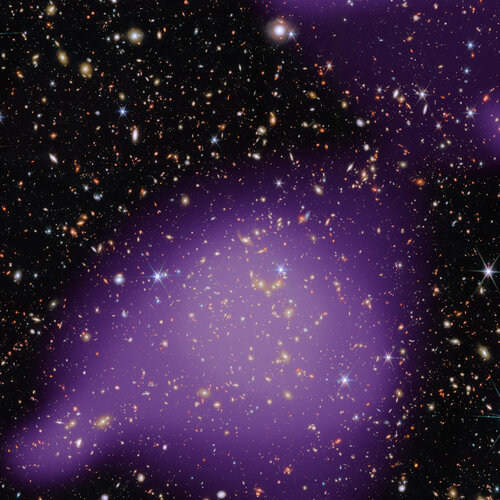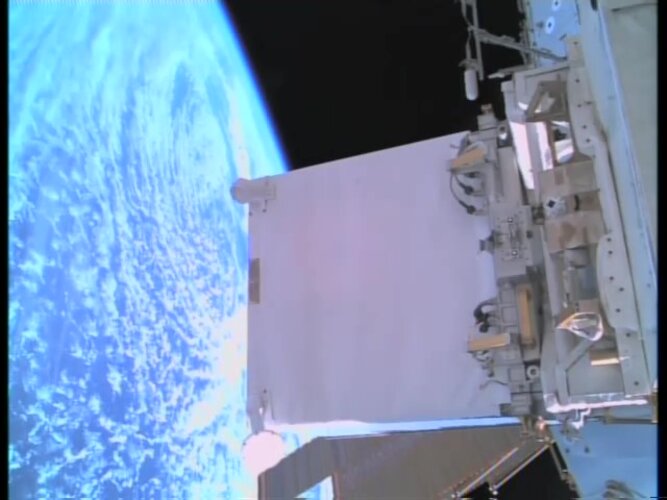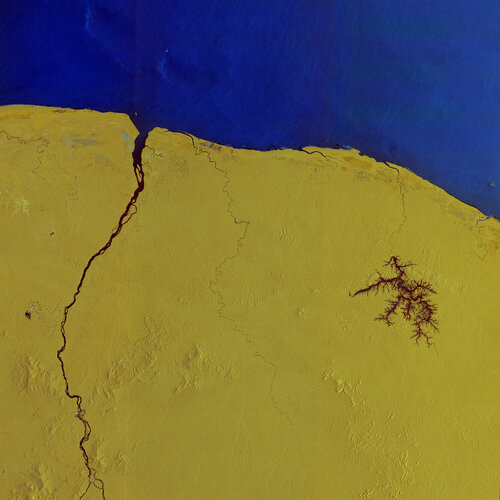Replay: Biomass launch coverage
Tuesday, 29 April 2025 09:30 Video:
01:54:04
Video:
01:54:04
ESA’s state-of-the-art Biomass satellite launched aboard a Vega-C rocket from Europe’s Spaceport in Kourou, French Guiana. The rocket lifted off on 29 April 2025 at 11:15 CEST (06:15 local time).
In orbit, this latest Earth Explorer mission will provide vital insights into the health and dynamics of the world’s forests, revealing how they are changing over time and, critically, enhancing our understanding of their role in the global carbon cycle. It is the first satellite to carry a fully polarimetric P-band synthetic aperture radar for interferometric imaging. Thanks to the long wavelength of P-band, around 70 cm, the
ESA’s Biomass mission launches on Vega-C
Tuesday, 29 April 2025 08:30 Video:
00:02:01
Video:
00:02:01
ESA’s state-of-the-art Biomass satellite has launched aboard a Vega-C rocket from Europe’s Spaceport in French Guiana. The rocket lifted off on 29 April 2025 at 11:15 CEST (06:15 local time).
In orbit, this latest Earth Explorer mission will provide vital insights into the health and dynamics of the world’s forests, revealing how they are changing over time and, critically, enhancing our understanding of their role in the global carbon cycle. It is the first satellite to carry a fully polarimetric P-band synthetic aperture radar for interferometric imaging. Thanks to the long wavelength of P-band, around 70 cm, the
A visual feast of galaxies, from infrared to X-ray
Tuesday, 29 April 2025 07:00 Image:
Webb: A visual feast of galaxies, from infrared to X-ray
Image:
Webb: A visual feast of galaxies, from infrared to X-ray Mission control GO for Biomass launch
Monday, 28 April 2025 14:00 Image:
Mission control GO for Biomass launch
Image:
Mission control GO for Biomass launch Ignis science
Monday, 28 April 2025 13:57
ESA project astronaut Sławosz Uznański-Wiśniewski will conduct a variety of science experiments and technology demonstrations during the Ignis mission. While the International Space Station is a home away from Earth for astronauts, it is, above all, a state-of-the-art laboratory in orbit. Its unique microgravity environment allows researchers to study phenomena that are impossible to replicate on our planet.
ACES in space
Monday, 28 April 2025 12:30 Image:
Image:
The Atomic Clock Ensemble in Space (ACES), ESA’s state-of-the-art timekeeping facility, is now installed on the Columbus laboratory of the International Space Station. This still image, captured by external cameras on the Station, shows ACES after installation. For 25 years, cameras on the Station have documented activities in orbit, providing real-time views of operations like this one – a rare and remarkable perspective from space.
On 25 April, the Canadian Space Agency’s robotic arm carefully extracted ACES from the SpaceX Dragon trunk and secured it onto the Columbus External Payload Facility, next to ESA’s space storm hunter ASIM
Upcoming ESA–Industry events prepare for Ministerial Council 2025
Monday, 28 April 2025 10:40
The European Space Agency (ESA) invites the industrial community to several events where ESA directorates will communicate and coordinate with industry on their proposals and intentions in relation to its Council Meeting at Ministerial Level (CM25) in November.
Biomass: from Europe to French Guiana
Monday, 28 April 2025 10:00 Video:
00:02:54
Video:
00:02:54
ESA’s Biomass satellite has been at Europe’s Spaceport in French Guiana since early March, undergoing final preparations for launch aboard a Vega-C rocket. This timelapse video captures key stages of its journey — from its arrival in Kourou to its installation in the launch tower.
Once in orbit, this latest Earth Explorer mission will provide vital insights into the health and dynamics of the world’s forests, revealing how they are changing over time and, critically, enhancing our understanding of their role in the global carbon cycle.
Biomass poised for liftoff to unveil forest secrets
Monday, 28 April 2025 06:00
After years of careful design and preparation, ESA’s Earth Explorer Biomass satellite is set for launch tomorrow, 29 April at 11:15 CEST, aboard a Vega-C rocket from Europe’s Spaceport in French Guiana.
This groundbreaking mission will offer unprecedented insights into the state and evolution of the world’s forests. By mapping the woody material in Earth’s forests, this revolutionary satellite will play a crucial role in deepening our understanding of how forests influence the global carbon cycle.
ACES finds its home in orbit
Friday, 25 April 2025 13:00
The Atomic Clock Ensemble in Space (ACES), ESA’s state-of-the-art timekeeping facility, has been successfully installed on the International Space Station, marking the start of a new chapter in space-based precision science.
Celebrating 20 years of KUBIK: a cornerstone of life science research in space
Friday, 25 April 2025 08:13
On 19 April 2025, ESA marks the 21st anniversary of KUBIK, an incubator for biological samples in space. This versatile and enduring facility has advanced our understanding of biology in space for the last two decades.
Earth from Space: French Guiana
Friday, 25 April 2025 07:00 Image:
Copernicus Sentinel-1 captured this radar image over French Guiana – home to Europe’s Spaceport in Kourou, where ESA’s Biomass mission is being prepared for liftoff on 29 April onboard a Vega-C rocket.
Image:
Copernicus Sentinel-1 captured this radar image over French Guiana – home to Europe’s Spaceport in Kourou, where ESA’s Biomass mission is being prepared for liftoff on 29 April onboard a Vega-C rocket. Three Chinese astronauts blast off for Tiangong space station
Thursday, 24 April 2025 13:03 A Chinese rocket carrying three astronauts to the country's space station blasted off from its remote launch site Thursday, the latest milestone in Beijing's race to become a leading celestial power.
Beijing has pumped billions of dollars into its space programme in recent years in an effort to achieve what President Xi Jinping describes as the Chinese people's "space dream".
The world's
A Chinese rocket carrying three astronauts to the country's space station blasted off from its remote launch site Thursday, the latest milestone in Beijing's race to become a leading celestial power.
Beijing has pumped billions of dollars into its space programme in recent years in an effort to achieve what President Xi Jinping describes as the Chinese people's "space dream".
The world's Rocket Lab to Conduct Hypersonic Test Flight Under MACH-TB 2.0 Program
Thursday, 24 April 2025 13:03 Rocket Lab USA, Inc. (Nasdaq: RKLB), a key provider of launch services and space systems, has secured a new contract to launch a full-scale hypersonic test flight on behalf of the U.S. Department of Defense. The mission, commissioned by Kratos under the MACH-TB 2.0 initiative, will utilize Rocket Lab's HASTE vehicle and is scheduled to lift off from Launch Complex 2 at Wallops Island, Virginia,
Rocket Lab USA, Inc. (Nasdaq: RKLB), a key provider of launch services and space systems, has secured a new contract to launch a full-scale hypersonic test flight on behalf of the U.S. Department of Defense. The mission, commissioned by Kratos under the MACH-TB 2.0 initiative, will utilize Rocket Lab's HASTE vehicle and is scheduled to lift off from Launch Complex 2 at Wallops Island, Virginia, China selects global payloads and opens lunar samples to foreign scientists
Thursday, 24 April 2025 13:03 China has announced the selection of 10 international payloads for its upcoming Chang'e 8 lunar mission, underscoring its commitment to global collaboration in space science. The China National Space Administration (CNSA) revealed that the chosen experiments span 11 nations and regions, including a specialized project from the International Society for Terrain-Vehicle Systems.
Among the se
China has announced the selection of 10 international payloads for its upcoming Chang'e 8 lunar mission, underscoring its commitment to global collaboration in space science. The China National Space Administration (CNSA) revealed that the chosen experiments span 11 nations and regions, including a specialized project from the International Society for Terrain-Vehicle Systems.
Among the se 
